Australia's Economic Growth: Trends, Challenges, and Opportunities
VerifiedAdded on 2023/06/11
|11
|2654
|67
Report
AI Summary
This report provides a detailed analysis of Australia's economic growth over the past decade, examining the fluctuating growth rates from 2005 to 2016, the impact of the global financial crisis and the mining boom, and the subsequent challenges faced by the Australian economy. It identifies key factors contributing to growth variance, including global events, internal policies, commodity prices, and investment levels. The report also highlights major challenges such as unemployment, low commodity prices, and the need for a more conducive macroeconomic environment. It further discusses the effectiveness of fiscal and monetary policies implemented by the Australian government to stimulate economic activity and suggests the need for addressing wage growth, infrastructure investment, and technological advancement to enhance Australia's economic performance. The report concludes by emphasizing the importance of a business-friendly environment and strategic policy interventions to overcome the current economic challenges and foster sustainable growth.
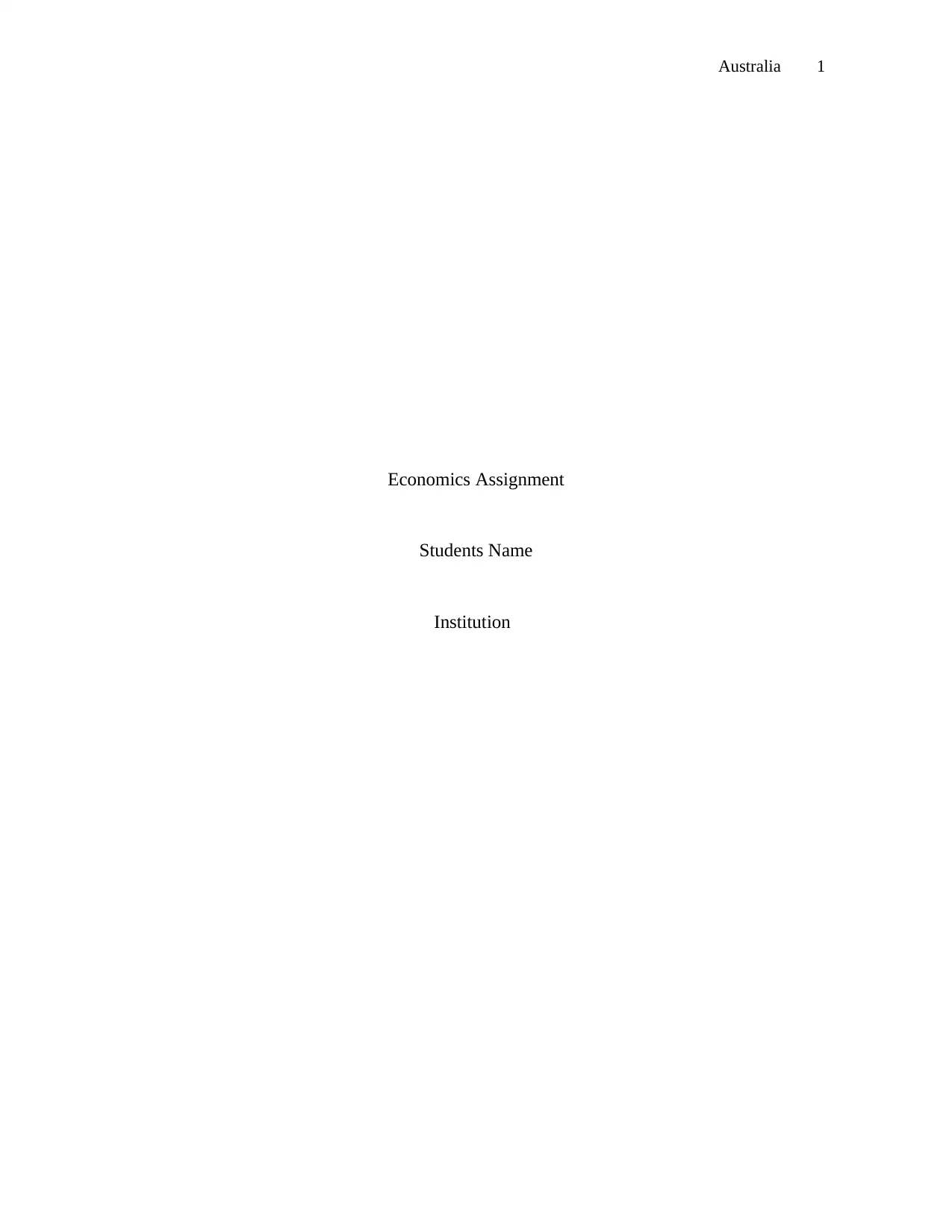
Australia 1
Economics Assignment
Students Name
Institution
Economics Assignment
Students Name
Institution
Paraphrase This Document
Need a fresh take? Get an instant paraphrase of this document with our AI Paraphraser
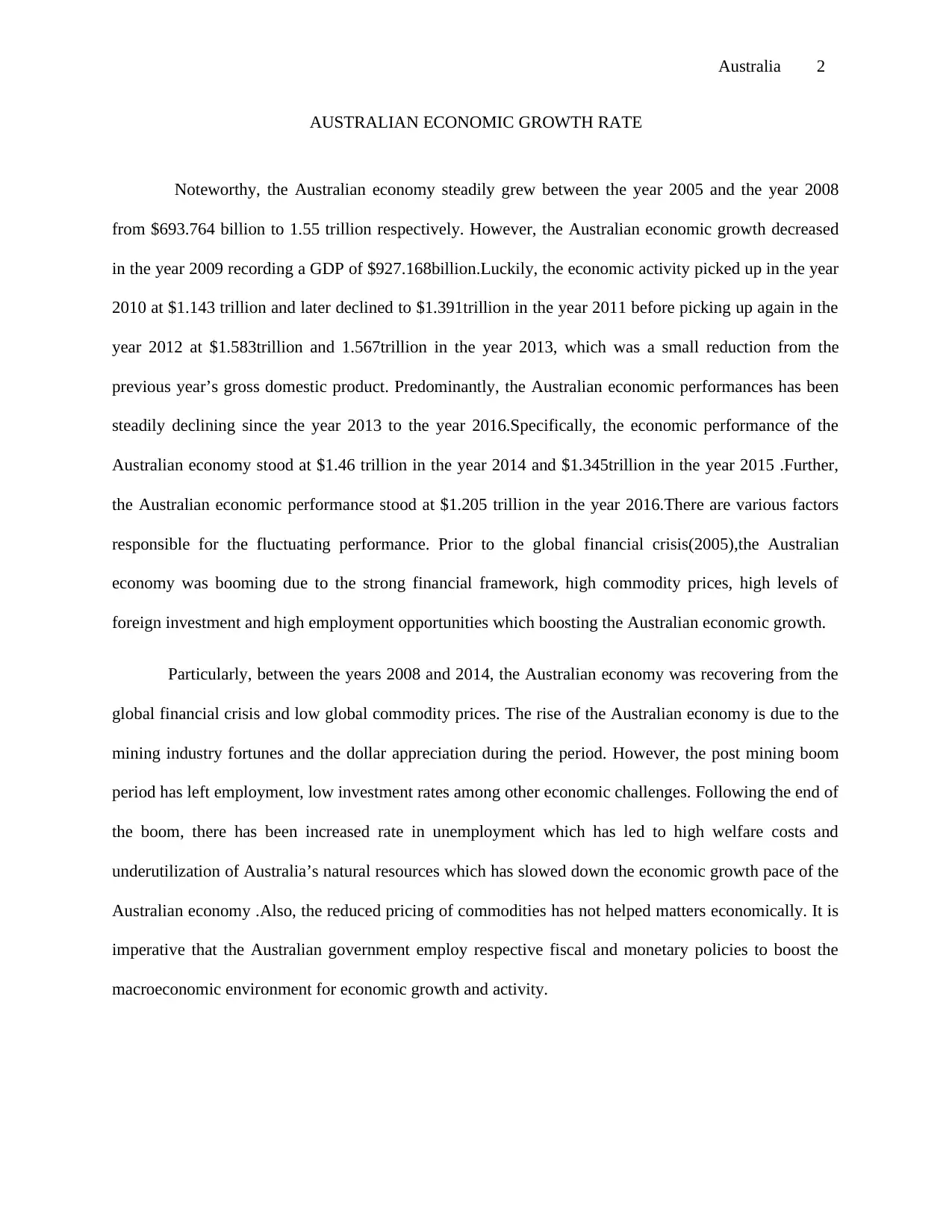
Australia 2
AUSTRALIAN ECONOMIC GROWTH RATE
Noteworthy, the Australian economy steadily grew between the year 2005 and the year 2008
from $693.764 billion to 1.55 trillion respectively. However, the Australian economic growth decreased
in the year 2009 recording a GDP of $927.168billion.Luckily, the economic activity picked up in the year
2010 at $1.143 trillion and later declined to $1.391trillion in the year 2011 before picking up again in the
year 2012 at $1.583trillion and 1.567trillion in the year 2013, which was a small reduction from the
previous year’s gross domestic product. Predominantly, the Australian economic performances has been
steadily declining since the year 2013 to the year 2016.Specifically, the economic performance of the
Australian economy stood at $1.46 trillion in the year 2014 and $1.345trillion in the year 2015 .Further,
the Australian economic performance stood at $1.205 trillion in the year 2016.There are various factors
responsible for the fluctuating performance. Prior to the global financial crisis(2005),the Australian
economy was booming due to the strong financial framework, high commodity prices, high levels of
foreign investment and high employment opportunities which boosting the Australian economic growth.
Particularly, between the years 2008 and 2014, the Australian economy was recovering from the
global financial crisis and low global commodity prices. The rise of the Australian economy is due to the
mining industry fortunes and the dollar appreciation during the period. However, the post mining boom
period has left employment, low investment rates among other economic challenges. Following the end of
the boom, there has been increased rate in unemployment which has led to high welfare costs and
underutilization of Australia’s natural resources which has slowed down the economic growth pace of the
Australian economy .Also, the reduced pricing of commodities has not helped matters economically. It is
imperative that the Australian government employ respective fiscal and monetary policies to boost the
macroeconomic environment for economic growth and activity.
AUSTRALIAN ECONOMIC GROWTH RATE
Noteworthy, the Australian economy steadily grew between the year 2005 and the year 2008
from $693.764 billion to 1.55 trillion respectively. However, the Australian economic growth decreased
in the year 2009 recording a GDP of $927.168billion.Luckily, the economic activity picked up in the year
2010 at $1.143 trillion and later declined to $1.391trillion in the year 2011 before picking up again in the
year 2012 at $1.583trillion and 1.567trillion in the year 2013, which was a small reduction from the
previous year’s gross domestic product. Predominantly, the Australian economic performances has been
steadily declining since the year 2013 to the year 2016.Specifically, the economic performance of the
Australian economy stood at $1.46 trillion in the year 2014 and $1.345trillion in the year 2015 .Further,
the Australian economic performance stood at $1.205 trillion in the year 2016.There are various factors
responsible for the fluctuating performance. Prior to the global financial crisis(2005),the Australian
economy was booming due to the strong financial framework, high commodity prices, high levels of
foreign investment and high employment opportunities which boosting the Australian economic growth.
Particularly, between the years 2008 and 2014, the Australian economy was recovering from the
global financial crisis and low global commodity prices. The rise of the Australian economy is due to the
mining industry fortunes and the dollar appreciation during the period. However, the post mining boom
period has left employment, low investment rates among other economic challenges. Following the end of
the boom, there has been increased rate in unemployment which has led to high welfare costs and
underutilization of Australia’s natural resources which has slowed down the economic growth pace of the
Australian economy .Also, the reduced pricing of commodities has not helped matters economically. It is
imperative that the Australian government employ respective fiscal and monetary policies to boost the
macroeconomic environment for economic growth and activity.
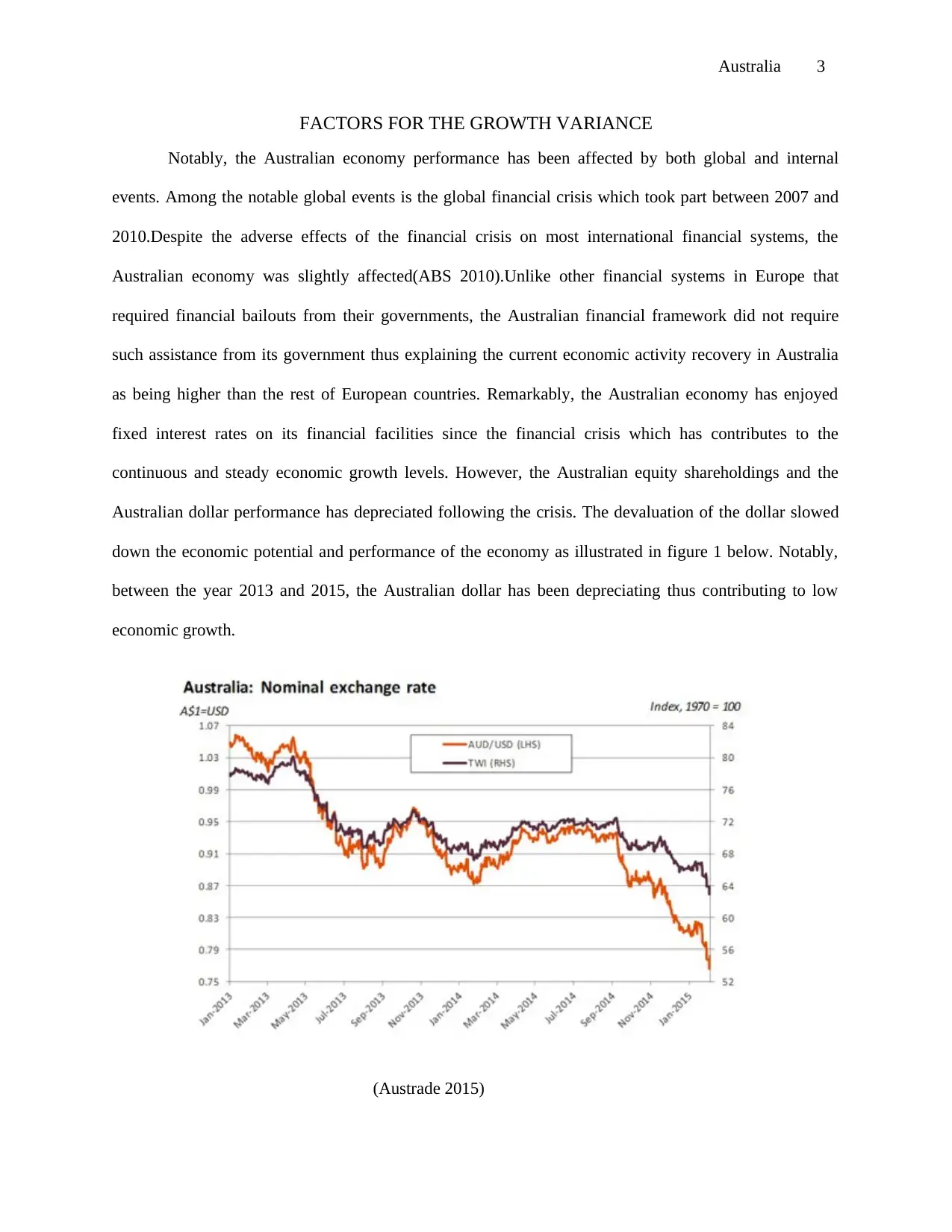
Australia 3
FACTORS FOR THE GROWTH VARIANCE
Notably, the Australian economy performance has been affected by both global and internal
events. Among the notable global events is the global financial crisis which took part between 2007 and
2010.Despite the adverse effects of the financial crisis on most international financial systems, the
Australian economy was slightly affected(ABS 2010).Unlike other financial systems in Europe that
required financial bailouts from their governments, the Australian financial framework did not require
such assistance from its government thus explaining the current economic activity recovery in Australia
as being higher than the rest of European countries. Remarkably, the Australian economy has enjoyed
fixed interest rates on its financial facilities since the financial crisis which has contributes to the
continuous and steady economic growth levels. However, the Australian equity shareholdings and the
Australian dollar performance has depreciated following the crisis. The devaluation of the dollar slowed
down the economic potential and performance of the economy as illustrated in figure 1 below. Notably,
between the year 2013 and 2015, the Australian dollar has been depreciating thus contributing to low
economic growth.
(Austrade 2015)
FACTORS FOR THE GROWTH VARIANCE
Notably, the Australian economy performance has been affected by both global and internal
events. Among the notable global events is the global financial crisis which took part between 2007 and
2010.Despite the adverse effects of the financial crisis on most international financial systems, the
Australian economy was slightly affected(ABS 2010).Unlike other financial systems in Europe that
required financial bailouts from their governments, the Australian financial framework did not require
such assistance from its government thus explaining the current economic activity recovery in Australia
as being higher than the rest of European countries. Remarkably, the Australian economy has enjoyed
fixed interest rates on its financial facilities since the financial crisis which has contributes to the
continuous and steady economic growth levels. However, the Australian equity shareholdings and the
Australian dollar performance has depreciated following the crisis. The devaluation of the dollar slowed
down the economic potential and performance of the economy as illustrated in figure 1 below. Notably,
between the year 2013 and 2015, the Australian dollar has been depreciating thus contributing to low
economic growth.
(Austrade 2015)
⊘ This is a preview!⊘
Do you want full access?
Subscribe today to unlock all pages.

Trusted by 1+ million students worldwide

Australia 4
Further, the mining boom positively boosted the economic growth rate of the Australian economy
(Downes, Hanslow and Tulip 2014).Through increased mining activity and investment ,the value of the
Australian dollar went up thus contributing to the economic growth of the Australian economy. With
higher foreign exchange values due to the dollar appreciation, the value of goods and services went up
which greatly benefitted the Australian gross domestic product.Alsongside increased revenue contribution
of the mining sector towards the Australian overall economic value, the boom created more employment
opportunities in the industry and other supportive industries leading to increased internal and external
revenue for the Australian households and government(Figure 1).The boom attracted foreign investment
into the sector of mining thereby creating more work and revenue for the economy. The high value of the
Australian dollar during the boom also uplifted the housing and construction industries values whose
contribution has increased the economic performance of the Australian economy. The mining industry
was the largest economic revenue contributor between the year 2013 and 2016.
(Phillips 2016)
After the end of the mining boom, the level of economic activity in the mining sector slowed
down. Not only the mining activity slow down but the sector contribution to the gross domestic product
slowed down too. Following the boom, there was massive investment opportunities by locals and
foreigners .However, towards the end of the boom, there was reduced investment in the mining
Further, the mining boom positively boosted the economic growth rate of the Australian economy
(Downes, Hanslow and Tulip 2014).Through increased mining activity and investment ,the value of the
Australian dollar went up thus contributing to the economic growth of the Australian economy. With
higher foreign exchange values due to the dollar appreciation, the value of goods and services went up
which greatly benefitted the Australian gross domestic product.Alsongside increased revenue contribution
of the mining sector towards the Australian overall economic value, the boom created more employment
opportunities in the industry and other supportive industries leading to increased internal and external
revenue for the Australian households and government(Figure 1).The boom attracted foreign investment
into the sector of mining thereby creating more work and revenue for the economy. The high value of the
Australian dollar during the boom also uplifted the housing and construction industries values whose
contribution has increased the economic performance of the Australian economy. The mining industry
was the largest economic revenue contributor between the year 2013 and 2016.
(Phillips 2016)
After the end of the mining boom, the level of economic activity in the mining sector slowed
down. Not only the mining activity slow down but the sector contribution to the gross domestic product
slowed down too. Following the boom, there was massive investment opportunities by locals and
foreigners .However, towards the end of the boom, there was reduced investment in the mining
Paraphrase This Document
Need a fresh take? Get an instant paraphrase of this document with our AI Paraphraser
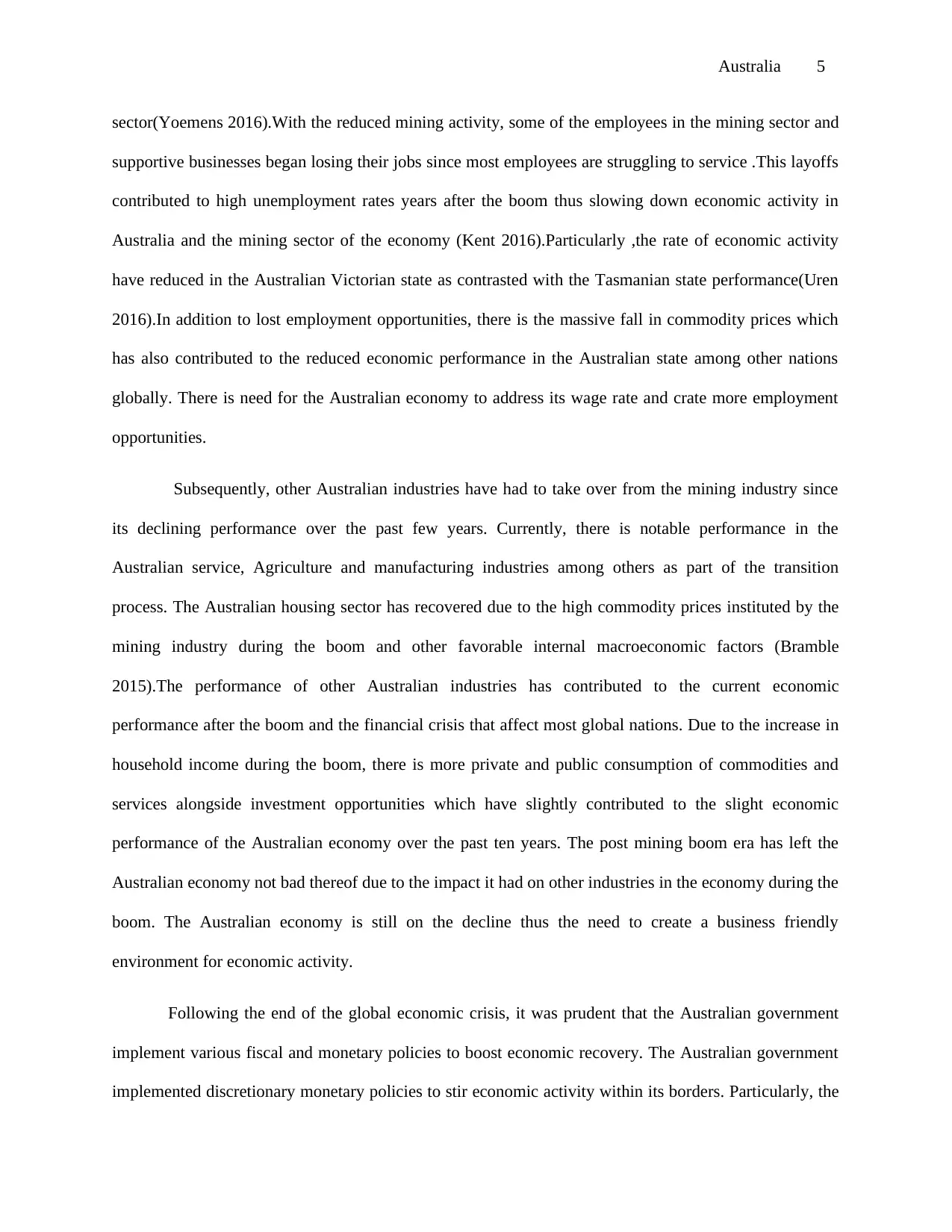
Australia 5
sector(Yoemens 2016).With the reduced mining activity, some of the employees in the mining sector and
supportive businesses began losing their jobs since most employees are struggling to service .This layoffs
contributed to high unemployment rates years after the boom thus slowing down economic activity in
Australia and the mining sector of the economy (Kent 2016).Particularly ,the rate of economic activity
have reduced in the Australian Victorian state as contrasted with the Tasmanian state performance(Uren
2016).In addition to lost employment opportunities, there is the massive fall in commodity prices which
has also contributed to the reduced economic performance in the Australian state among other nations
globally. There is need for the Australian economy to address its wage rate and crate more employment
opportunities.
Subsequently, other Australian industries have had to take over from the mining industry since
its declining performance over the past few years. Currently, there is notable performance in the
Australian service, Agriculture and manufacturing industries among others as part of the transition
process. The Australian housing sector has recovered due to the high commodity prices instituted by the
mining industry during the boom and other favorable internal macroeconomic factors (Bramble
2015).The performance of other Australian industries has contributed to the current economic
performance after the boom and the financial crisis that affect most global nations. Due to the increase in
household income during the boom, there is more private and public consumption of commodities and
services alongside investment opportunities which have slightly contributed to the slight economic
performance of the Australian economy over the past ten years. The post mining boom era has left the
Australian economy not bad thereof due to the impact it had on other industries in the economy during the
boom. The Australian economy is still on the decline thus the need to create a business friendly
environment for economic activity.
Following the end of the global economic crisis, it was prudent that the Australian government
implement various fiscal and monetary policies to boost economic recovery. The Australian government
implemented discretionary monetary policies to stir economic activity within its borders. Particularly, the
sector(Yoemens 2016).With the reduced mining activity, some of the employees in the mining sector and
supportive businesses began losing their jobs since most employees are struggling to service .This layoffs
contributed to high unemployment rates years after the boom thus slowing down economic activity in
Australia and the mining sector of the economy (Kent 2016).Particularly ,the rate of economic activity
have reduced in the Australian Victorian state as contrasted with the Tasmanian state performance(Uren
2016).In addition to lost employment opportunities, there is the massive fall in commodity prices which
has also contributed to the reduced economic performance in the Australian state among other nations
globally. There is need for the Australian economy to address its wage rate and crate more employment
opportunities.
Subsequently, other Australian industries have had to take over from the mining industry since
its declining performance over the past few years. Currently, there is notable performance in the
Australian service, Agriculture and manufacturing industries among others as part of the transition
process. The Australian housing sector has recovered due to the high commodity prices instituted by the
mining industry during the boom and other favorable internal macroeconomic factors (Bramble
2015).The performance of other Australian industries has contributed to the current economic
performance after the boom and the financial crisis that affect most global nations. Due to the increase in
household income during the boom, there is more private and public consumption of commodities and
services alongside investment opportunities which have slightly contributed to the slight economic
performance of the Australian economy over the past ten years. The post mining boom era has left the
Australian economy not bad thereof due to the impact it had on other industries in the economy during the
boom. The Australian economy is still on the decline thus the need to create a business friendly
environment for economic activity.
Following the end of the global economic crisis, it was prudent that the Australian government
implement various fiscal and monetary policies to boost economic recovery. The Australian government
implemented discretionary monetary policies to stir economic activity within its borders. Particularly, the
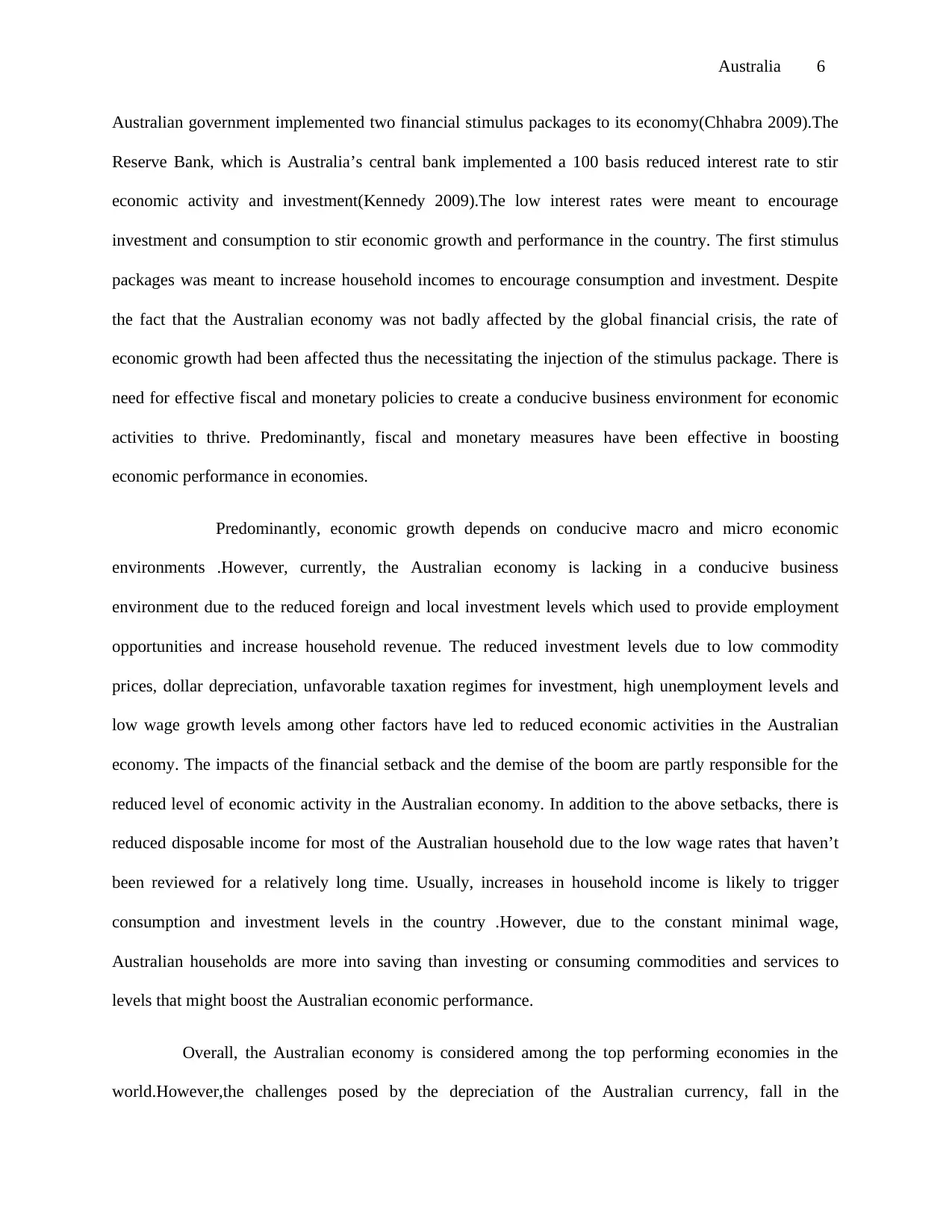
Australia 6
Australian government implemented two financial stimulus packages to its economy(Chhabra 2009).The
Reserve Bank, which is Australia’s central bank implemented a 100 basis reduced interest rate to stir
economic activity and investment(Kennedy 2009).The low interest rates were meant to encourage
investment and consumption to stir economic growth and performance in the country. The first stimulus
packages was meant to increase household incomes to encourage consumption and investment. Despite
the fact that the Australian economy was not badly affected by the global financial crisis, the rate of
economic growth had been affected thus the necessitating the injection of the stimulus package. There is
need for effective fiscal and monetary policies to create a conducive business environment for economic
activities to thrive. Predominantly, fiscal and monetary measures have been effective in boosting
economic performance in economies.
Predominantly, economic growth depends on conducive macro and micro economic
environments .However, currently, the Australian economy is lacking in a conducive business
environment due to the reduced foreign and local investment levels which used to provide employment
opportunities and increase household revenue. The reduced investment levels due to low commodity
prices, dollar depreciation, unfavorable taxation regimes for investment, high unemployment levels and
low wage growth levels among other factors have led to reduced economic activities in the Australian
economy. The impacts of the financial setback and the demise of the boom are partly responsible for the
reduced level of economic activity in the Australian economy. In addition to the above setbacks, there is
reduced disposable income for most of the Australian household due to the low wage rates that haven’t
been reviewed for a relatively long time. Usually, increases in household income is likely to trigger
consumption and investment levels in the country .However, due to the constant minimal wage,
Australian households are more into saving than investing or consuming commodities and services to
levels that might boost the Australian economic performance.
Overall, the Australian economy is considered among the top performing economies in the
world.However,the challenges posed by the depreciation of the Australian currency, fall in the
Australian government implemented two financial stimulus packages to its economy(Chhabra 2009).The
Reserve Bank, which is Australia’s central bank implemented a 100 basis reduced interest rate to stir
economic activity and investment(Kennedy 2009).The low interest rates were meant to encourage
investment and consumption to stir economic growth and performance in the country. The first stimulus
packages was meant to increase household incomes to encourage consumption and investment. Despite
the fact that the Australian economy was not badly affected by the global financial crisis, the rate of
economic growth had been affected thus the necessitating the injection of the stimulus package. There is
need for effective fiscal and monetary policies to create a conducive business environment for economic
activities to thrive. Predominantly, fiscal and monetary measures have been effective in boosting
economic performance in economies.
Predominantly, economic growth depends on conducive macro and micro economic
environments .However, currently, the Australian economy is lacking in a conducive business
environment due to the reduced foreign and local investment levels which used to provide employment
opportunities and increase household revenue. The reduced investment levels due to low commodity
prices, dollar depreciation, unfavorable taxation regimes for investment, high unemployment levels and
low wage growth levels among other factors have led to reduced economic activities in the Australian
economy. The impacts of the financial setback and the demise of the boom are partly responsible for the
reduced level of economic activity in the Australian economy. In addition to the above setbacks, there is
reduced disposable income for most of the Australian household due to the low wage rates that haven’t
been reviewed for a relatively long time. Usually, increases in household income is likely to trigger
consumption and investment levels in the country .However, due to the constant minimal wage,
Australian households are more into saving than investing or consuming commodities and services to
levels that might boost the Australian economic performance.
Overall, the Australian economy is considered among the top performing economies in the
world.However,the challenges posed by the depreciation of the Australian currency, fall in the
⊘ This is a preview!⊘
Do you want full access?
Subscribe today to unlock all pages.

Trusted by 1+ million students worldwide
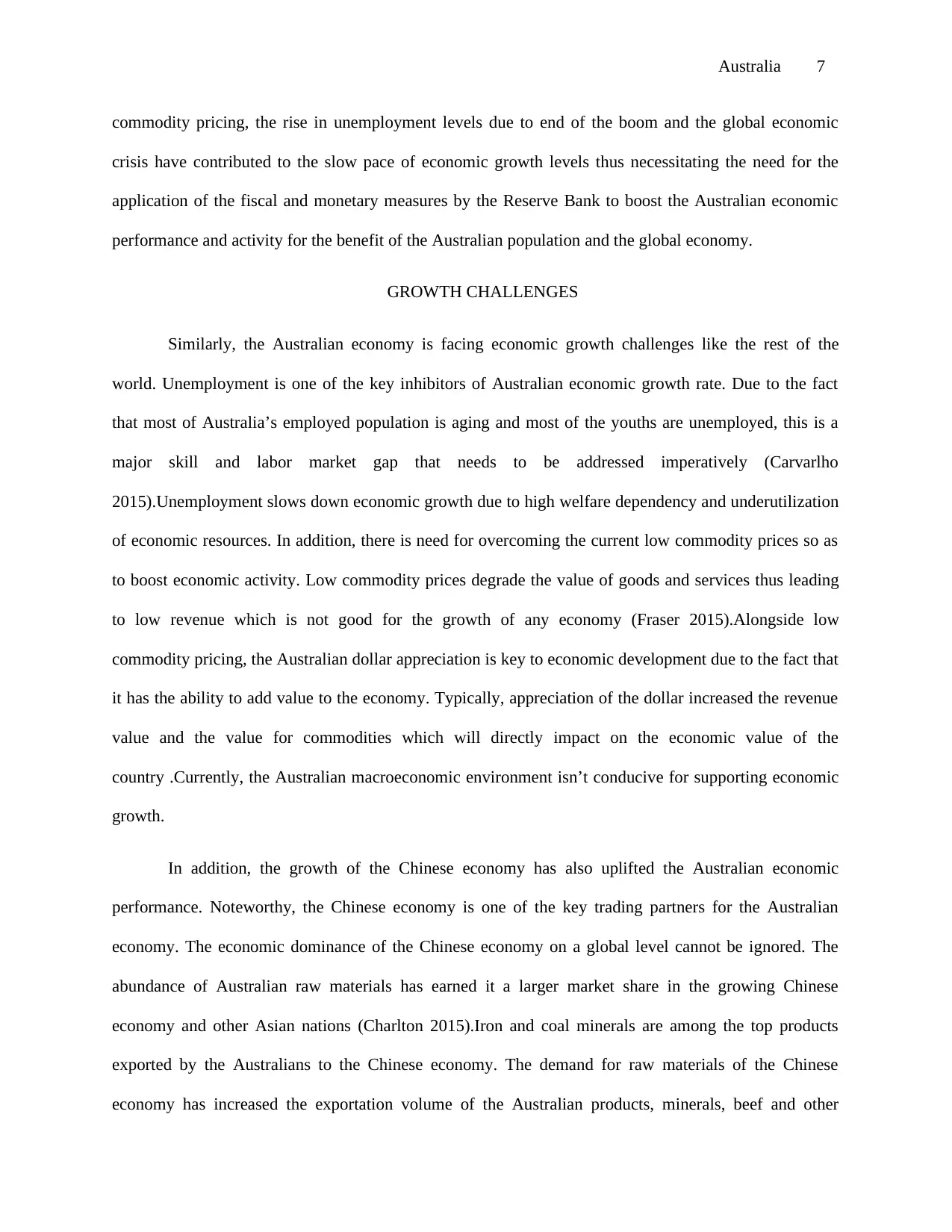
Australia 7
commodity pricing, the rise in unemployment levels due to end of the boom and the global economic
crisis have contributed to the slow pace of economic growth levels thus necessitating the need for the
application of the fiscal and monetary measures by the Reserve Bank to boost the Australian economic
performance and activity for the benefit of the Australian population and the global economy.
GROWTH CHALLENGES
Similarly, the Australian economy is facing economic growth challenges like the rest of the
world. Unemployment is one of the key inhibitors of Australian economic growth rate. Due to the fact
that most of Australia’s employed population is aging and most of the youths are unemployed, this is a
major skill and labor market gap that needs to be addressed imperatively (Carvarlho
2015).Unemployment slows down economic growth due to high welfare dependency and underutilization
of economic resources. In addition, there is need for overcoming the current low commodity prices so as
to boost economic activity. Low commodity prices degrade the value of goods and services thus leading
to low revenue which is not good for the growth of any economy (Fraser 2015).Alongside low
commodity pricing, the Australian dollar appreciation is key to economic development due to the fact that
it has the ability to add value to the economy. Typically, appreciation of the dollar increased the revenue
value and the value for commodities which will directly impact on the economic value of the
country .Currently, the Australian macroeconomic environment isn’t conducive for supporting economic
growth.
In addition, the growth of the Chinese economy has also uplifted the Australian economic
performance. Noteworthy, the Chinese economy is one of the key trading partners for the Australian
economy. The economic dominance of the Chinese economy on a global level cannot be ignored. The
abundance of Australian raw materials has earned it a larger market share in the growing Chinese
economy and other Asian nations (Charlton 2015).Iron and coal minerals are among the top products
exported by the Australians to the Chinese economy. The demand for raw materials of the Chinese
economy has increased the exportation volume of the Australian products, minerals, beef and other
commodity pricing, the rise in unemployment levels due to end of the boom and the global economic
crisis have contributed to the slow pace of economic growth levels thus necessitating the need for the
application of the fiscal and monetary measures by the Reserve Bank to boost the Australian economic
performance and activity for the benefit of the Australian population and the global economy.
GROWTH CHALLENGES
Similarly, the Australian economy is facing economic growth challenges like the rest of the
world. Unemployment is one of the key inhibitors of Australian economic growth rate. Due to the fact
that most of Australia’s employed population is aging and most of the youths are unemployed, this is a
major skill and labor market gap that needs to be addressed imperatively (Carvarlho
2015).Unemployment slows down economic growth due to high welfare dependency and underutilization
of economic resources. In addition, there is need for overcoming the current low commodity prices so as
to boost economic activity. Low commodity prices degrade the value of goods and services thus leading
to low revenue which is not good for the growth of any economy (Fraser 2015).Alongside low
commodity pricing, the Australian dollar appreciation is key to economic development due to the fact that
it has the ability to add value to the economy. Typically, appreciation of the dollar increased the revenue
value and the value for commodities which will directly impact on the economic value of the
country .Currently, the Australian macroeconomic environment isn’t conducive for supporting economic
growth.
In addition, the growth of the Chinese economy has also uplifted the Australian economic
performance. Noteworthy, the Chinese economy is one of the key trading partners for the Australian
economy. The economic dominance of the Chinese economy on a global level cannot be ignored. The
abundance of Australian raw materials has earned it a larger market share in the growing Chinese
economy and other Asian nations (Charlton 2015).Iron and coal minerals are among the top products
exported by the Australians to the Chinese economy. The demand for raw materials of the Chinese
economy has increased the exportation volume of the Australian products, minerals, beef and other
Paraphrase This Document
Need a fresh take? Get an instant paraphrase of this document with our AI Paraphraser
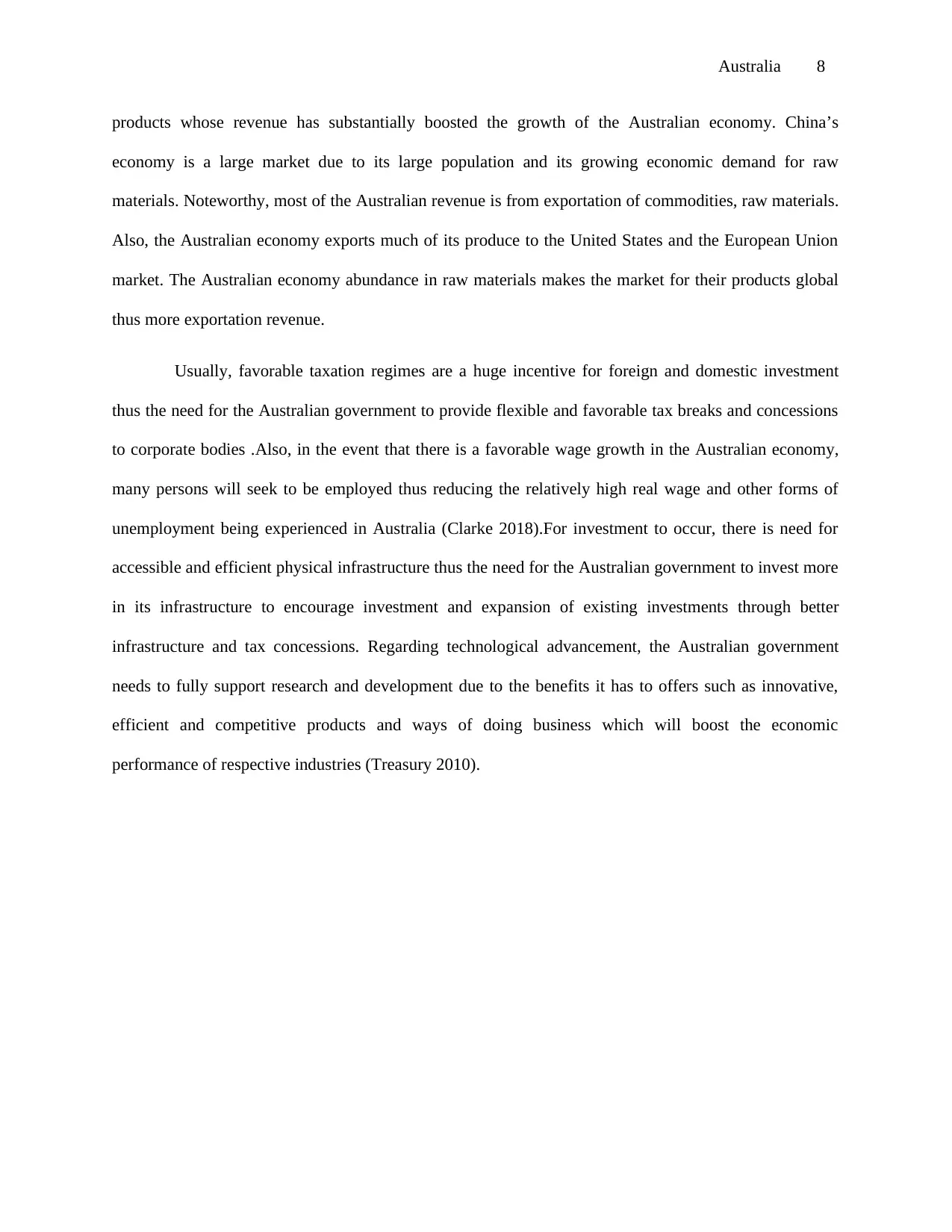
Australia 8
products whose revenue has substantially boosted the growth of the Australian economy. China’s
economy is a large market due to its large population and its growing economic demand for raw
materials. Noteworthy, most of the Australian revenue is from exportation of commodities, raw materials.
Also, the Australian economy exports much of its produce to the United States and the European Union
market. The Australian economy abundance in raw materials makes the market for their products global
thus more exportation revenue.
Usually, favorable taxation regimes are a huge incentive for foreign and domestic investment
thus the need for the Australian government to provide flexible and favorable tax breaks and concessions
to corporate bodies .Also, in the event that there is a favorable wage growth in the Australian economy,
many persons will seek to be employed thus reducing the relatively high real wage and other forms of
unemployment being experienced in Australia (Clarke 2018).For investment to occur, there is need for
accessible and efficient physical infrastructure thus the need for the Australian government to invest more
in its infrastructure to encourage investment and expansion of existing investments through better
infrastructure and tax concessions. Regarding technological advancement, the Australian government
needs to fully support research and development due to the benefits it has to offers such as innovative,
efficient and competitive products and ways of doing business which will boost the economic
performance of respective industries (Treasury 2010).
products whose revenue has substantially boosted the growth of the Australian economy. China’s
economy is a large market due to its large population and its growing economic demand for raw
materials. Noteworthy, most of the Australian revenue is from exportation of commodities, raw materials.
Also, the Australian economy exports much of its produce to the United States and the European Union
market. The Australian economy abundance in raw materials makes the market for their products global
thus more exportation revenue.
Usually, favorable taxation regimes are a huge incentive for foreign and domestic investment
thus the need for the Australian government to provide flexible and favorable tax breaks and concessions
to corporate bodies .Also, in the event that there is a favorable wage growth in the Australian economy,
many persons will seek to be employed thus reducing the relatively high real wage and other forms of
unemployment being experienced in Australia (Clarke 2018).For investment to occur, there is need for
accessible and efficient physical infrastructure thus the need for the Australian government to invest more
in its infrastructure to encourage investment and expansion of existing investments through better
infrastructure and tax concessions. Regarding technological advancement, the Australian government
needs to fully support research and development due to the benefits it has to offers such as innovative,
efficient and competitive products and ways of doing business which will boost the economic
performance of respective industries (Treasury 2010).
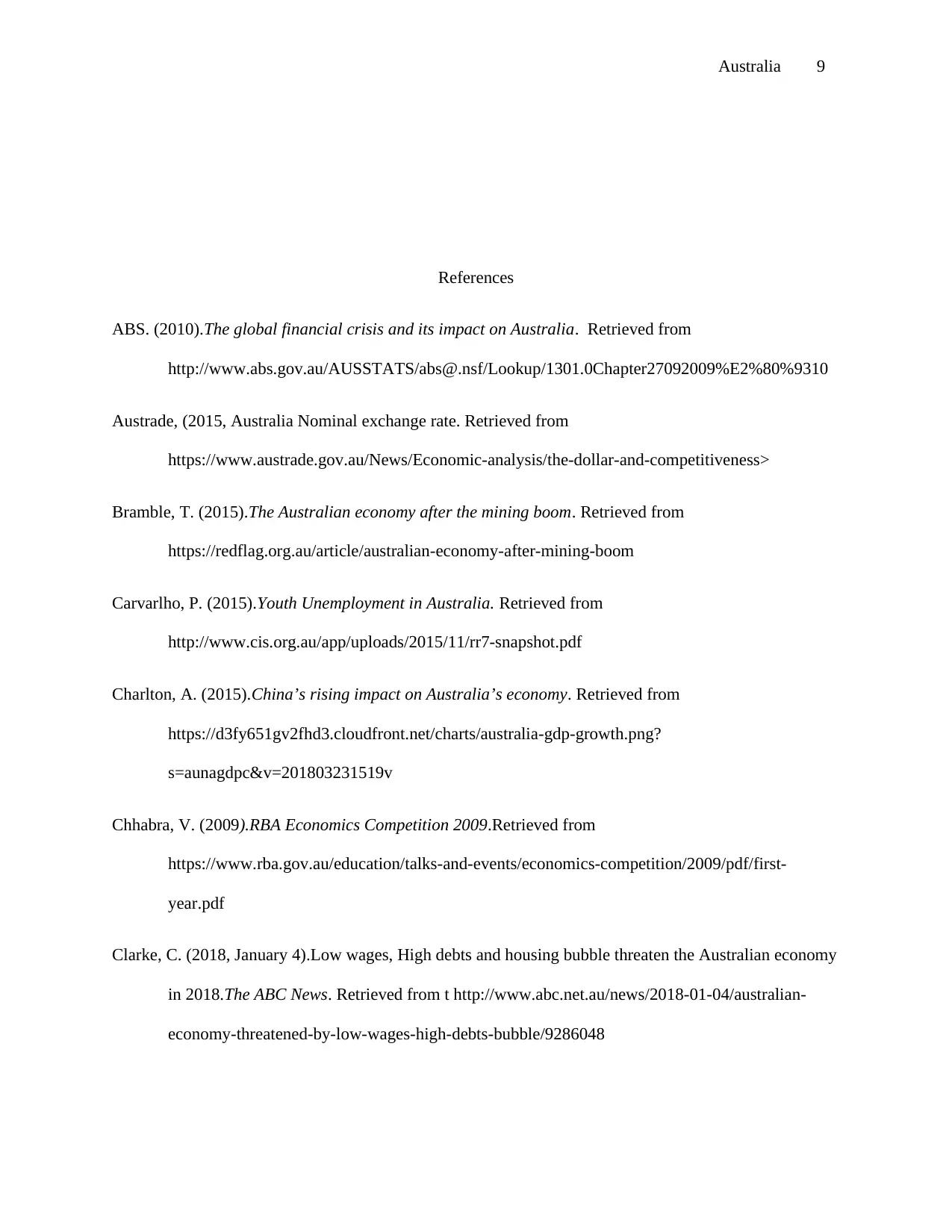
Australia 9
References
ABS. (2010).The global financial crisis and its impact on Australia. Retrieved from
http://www.abs.gov.au/AUSSTATS/abs@.nsf/Lookup/1301.0Chapter27092009%E2%80%9310
Austrade, (2015, Australia Nominal exchange rate. Retrieved from
https://www.austrade.gov.au/News/Economic-analysis/the-dollar-and-competitiveness>
Bramble, T. (2015).The Australian economy after the mining boom. Retrieved from
https://redflag.org.au/article/australian-economy-after-mining-boom
Carvarlho, P. (2015).Youth Unemployment in Australia. Retrieved from
http://www.cis.org.au/app/uploads/2015/11/rr7-snapshot.pdf
Charlton, A. (2015).China’s rising impact on Australia’s economy. Retrieved from
https://d3fy651gv2fhd3.cloudfront.net/charts/australia-gdp-growth.png?
s=aunagdpc&v=201803231519v
Chhabra, V. (2009).RBA Economics Competition 2009.Retrieved from
https://www.rba.gov.au/education/talks-and-events/economics-competition/2009/pdf/first-
year.pdf
Clarke, C. (2018, January 4).Low wages, High debts and housing bubble threaten the Australian economy
in 2018.The ABC News. Retrieved from t http://www.abc.net.au/news/2018-01-04/australian-
economy-threatened-by-low-wages-high-debts-bubble/9286048
References
ABS. (2010).The global financial crisis and its impact on Australia. Retrieved from
http://www.abs.gov.au/AUSSTATS/abs@.nsf/Lookup/1301.0Chapter27092009%E2%80%9310
Austrade, (2015, Australia Nominal exchange rate. Retrieved from
https://www.austrade.gov.au/News/Economic-analysis/the-dollar-and-competitiveness>
Bramble, T. (2015).The Australian economy after the mining boom. Retrieved from
https://redflag.org.au/article/australian-economy-after-mining-boom
Carvarlho, P. (2015).Youth Unemployment in Australia. Retrieved from
http://www.cis.org.au/app/uploads/2015/11/rr7-snapshot.pdf
Charlton, A. (2015).China’s rising impact on Australia’s economy. Retrieved from
https://d3fy651gv2fhd3.cloudfront.net/charts/australia-gdp-growth.png?
s=aunagdpc&v=201803231519v
Chhabra, V. (2009).RBA Economics Competition 2009.Retrieved from
https://www.rba.gov.au/education/talks-and-events/economics-competition/2009/pdf/first-
year.pdf
Clarke, C. (2018, January 4).Low wages, High debts and housing bubble threaten the Australian economy
in 2018.The ABC News. Retrieved from t http://www.abc.net.au/news/2018-01-04/australian-
economy-threatened-by-low-wages-high-debts-bubble/9286048
⊘ This is a preview!⊘
Do you want full access?
Subscribe today to unlock all pages.

Trusted by 1+ million students worldwide
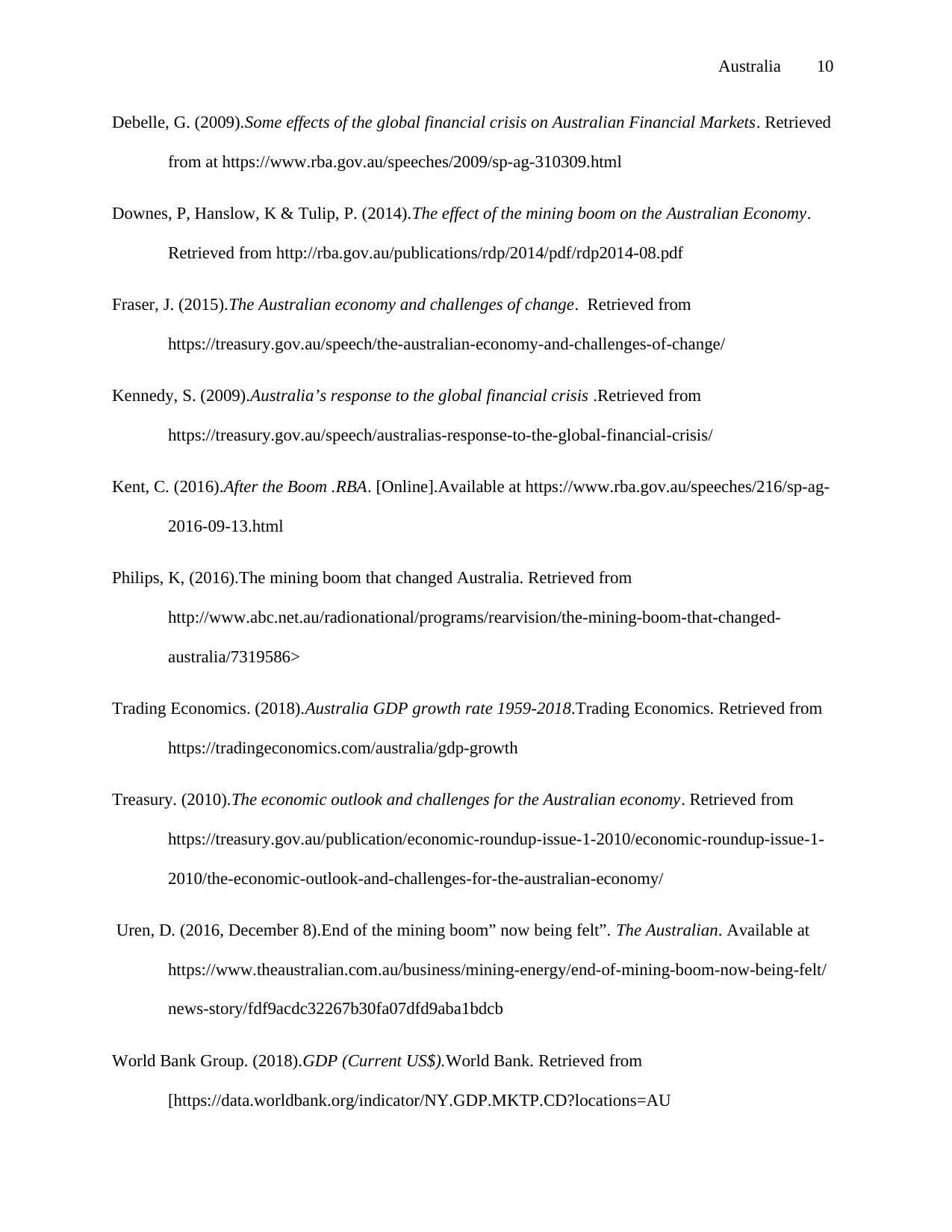
Australia 10
Debelle, G. (2009).Some effects of the global financial crisis on Australian Financial Markets. Retrieved
from at https://www.rba.gov.au/speeches/2009/sp-ag-310309.html
Downes, P, Hanslow, K & Tulip, P. (2014).The effect of the mining boom on the Australian Economy.
Retrieved from http://rba.gov.au/publications/rdp/2014/pdf/rdp2014-08.pdf
Fraser, J. (2015).The Australian economy and challenges of change. Retrieved from
https://treasury.gov.au/speech/the-australian-economy-and-challenges-of-change/
Kennedy, S. (2009).Australia’s response to the global financial crisis .Retrieved from
https://treasury.gov.au/speech/australias-response-to-the-global-financial-crisis/
Kent, C. (2016).After the Boom .RBA. [Online].Available at https://www.rba.gov.au/speeches/216/sp-ag-
2016-09-13.html
Philips, K, (2016).The mining boom that changed Australia. Retrieved from
http://www.abc.net.au/radionational/programs/rearvision/the-mining-boom-that-changed-
australia/7319586>
Trading Economics. (2018).Australia GDP growth rate 1959-2018.Trading Economics. Retrieved from
https://tradingeconomics.com/australia/gdp-growth
Treasury. (2010).The economic outlook and challenges for the Australian economy. Retrieved from
https://treasury.gov.au/publication/economic-roundup-issue-1-2010/economic-roundup-issue-1-
2010/the-economic-outlook-and-challenges-for-the-australian-economy/
Uren, D. (2016, December 8).End of the mining boom” now being felt”. The Australian. Available at
https://www.theaustralian.com.au/business/mining-energy/end-of-mining-boom-now-being-felt/
news-story/fdf9acdc32267b30fa07dfd9aba1bdcb
World Bank Group. (2018).GDP (Current US$).World Bank. Retrieved from
[https://data.worldbank.org/indicator/NY.GDP.MKTP.CD?locations=AU
Debelle, G. (2009).Some effects of the global financial crisis on Australian Financial Markets. Retrieved
from at https://www.rba.gov.au/speeches/2009/sp-ag-310309.html
Downes, P, Hanslow, K & Tulip, P. (2014).The effect of the mining boom on the Australian Economy.
Retrieved from http://rba.gov.au/publications/rdp/2014/pdf/rdp2014-08.pdf
Fraser, J. (2015).The Australian economy and challenges of change. Retrieved from
https://treasury.gov.au/speech/the-australian-economy-and-challenges-of-change/
Kennedy, S. (2009).Australia’s response to the global financial crisis .Retrieved from
https://treasury.gov.au/speech/australias-response-to-the-global-financial-crisis/
Kent, C. (2016).After the Boom .RBA. [Online].Available at https://www.rba.gov.au/speeches/216/sp-ag-
2016-09-13.html
Philips, K, (2016).The mining boom that changed Australia. Retrieved from
http://www.abc.net.au/radionational/programs/rearvision/the-mining-boom-that-changed-
australia/7319586>
Trading Economics. (2018).Australia GDP growth rate 1959-2018.Trading Economics. Retrieved from
https://tradingeconomics.com/australia/gdp-growth
Treasury. (2010).The economic outlook and challenges for the Australian economy. Retrieved from
https://treasury.gov.au/publication/economic-roundup-issue-1-2010/economic-roundup-issue-1-
2010/the-economic-outlook-and-challenges-for-the-australian-economy/
Uren, D. (2016, December 8).End of the mining boom” now being felt”. The Australian. Available at
https://www.theaustralian.com.au/business/mining-energy/end-of-mining-boom-now-being-felt/
news-story/fdf9acdc32267b30fa07dfd9aba1bdcb
World Bank Group. (2018).GDP (Current US$).World Bank. Retrieved from
[https://data.worldbank.org/indicator/NY.GDP.MKTP.CD?locations=AU
Paraphrase This Document
Need a fresh take? Get an instant paraphrase of this document with our AI Paraphraser
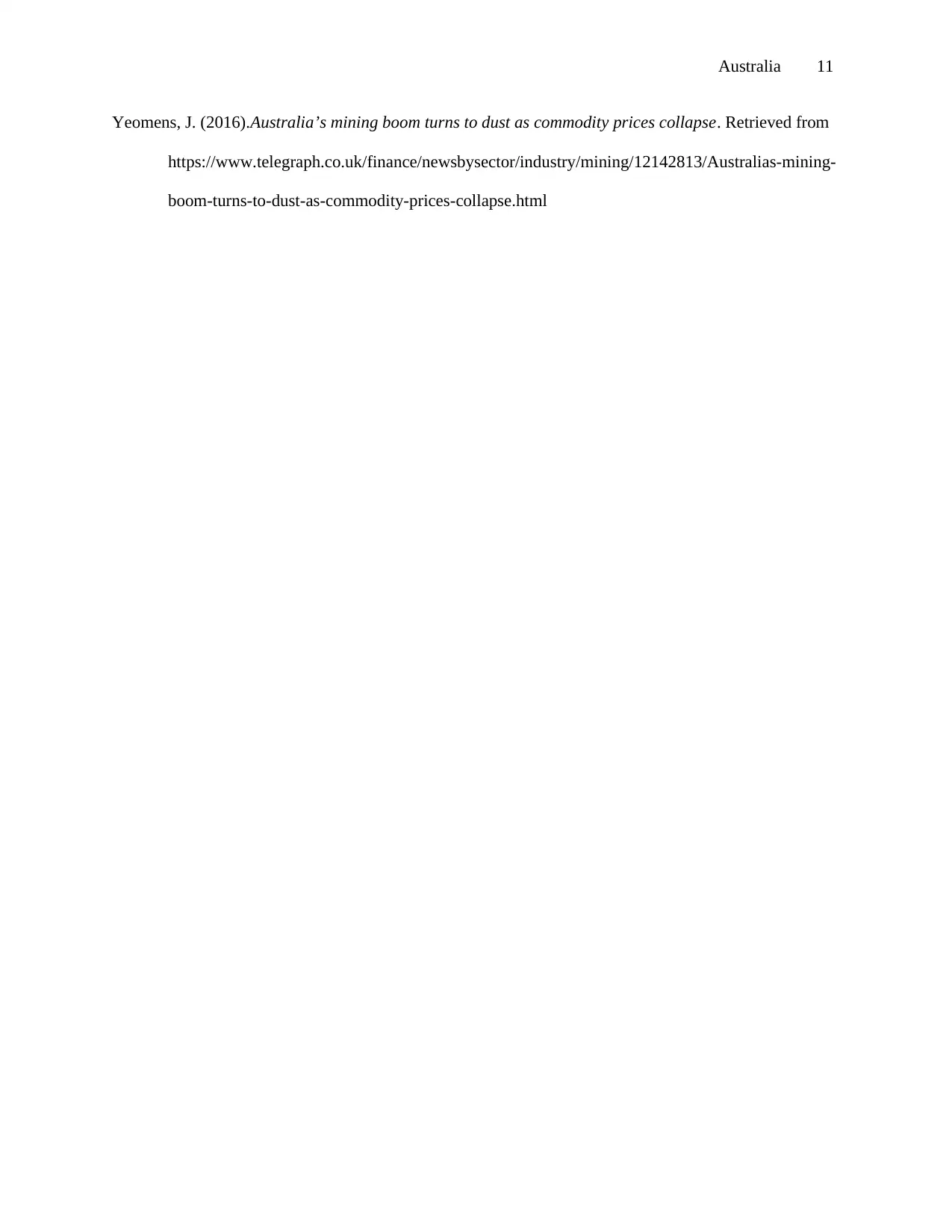
Australia 11
Yeomens, J. (2016).Australia’s mining boom turns to dust as commodity prices collapse. Retrieved from
https://www.telegraph.co.uk/finance/newsbysector/industry/mining/12142813/Australias-mining-
boom-turns-to-dust-as-commodity-prices-collapse.html
Yeomens, J. (2016).Australia’s mining boom turns to dust as commodity prices collapse. Retrieved from
https://www.telegraph.co.uk/finance/newsbysector/industry/mining/12142813/Australias-mining-
boom-turns-to-dust-as-commodity-prices-collapse.html
1 out of 11
Related Documents
Your All-in-One AI-Powered Toolkit for Academic Success.
+13062052269
info@desklib.com
Available 24*7 on WhatsApp / Email
![[object Object]](/_next/static/media/star-bottom.7253800d.svg)
Unlock your academic potential
Copyright © 2020–2025 A2Z Services. All Rights Reserved. Developed and managed by ZUCOL.





